Release 8.0.4 for Windows NT and Windows 95
A55913-01
Library |
Product |
Contents |
Index |
| Net8 Getting Started Release 8.0.4 for Windows NT and Windows 95 A55913-01 |
|
This chapter describes how to configure your network.
Specific topics discussed are:
Before a database server can receive connections from clients, clients must be configured with service names (easy to remember aliases for database addresses) that match the address preconfigured in each server machine's LISTENER.ORA file. These addresses are used by the client to connect to the network listener during a connection. During a connection, a client passes the system ID (SID) of the server to which it wants to connect.
The LISTENER.ORA file identifies and controls the behavior of the network listeners that listen for the databases on the machine. This file includes network listener descriptors and addresses of all network listeners on a machine, the SIDs of the databases they listen for, and various control parameters.
Client configuration is accomplished by creating a list of the service names and addresses of network destinations through a TNSNAMES.ORA client configuration file or an Oracle Names Server. A client (or a server that is part of a distributed database) needs this information to tell it where it can make connections.
Configuration is based upon one of two models:
Net8 can resolve service names using the following methods:
| Naming Methods | Description |
|---|---|
|
Host Naming |
Resolves service names through a TCP/IP network's Domain Name System (DNS) or in the /ETC/HOSTS file. This method is recommended for simple TCP/IP environments. |
|
Local Naming (no Oracle Names Server) |
Resolves service names to network addresses by using information configured and stored on each individual client. Local Naming is most appropriate for simple distributed networks with a small number of services that change infrequently. |
|
Oracle Names |
Oracle Names stores names and addresses of all database services on a network on an Oracle Names Server. Connection requests are routed through an Oracle Names Server, which resolves the service name to a network address. The information is then returned to the client. |
|
External Naming |
External naming refers to service name resolution by using a supported third-party naming service. See "Using the External Naming Method" in Chapter 8, "Performing Advanced Configuration". |
Depending on the naming method you use, the following configuration files may be created or modified in ORACLE_HOME\NET80\ADMIN:
|
Additional Information:
See Appendix C, "Configuration Files" for more information about these files. |
The host naming method is enabled by default during installation for TCP/IP network environments only. The LISTENER.ORA has a line which specifies the TCP/IP host name of your server. Clients that use this host name in their connect string, can connect.
Your client machine may connect to a database using the host name of the machine on which the database resides if:
Ensure GLOBAL_DBNAME = HOSTNAME as specified in the LISTENER.ORA configuration file, where HOSTNAME is the TCP/IP host name or alias of the server system.
During the installation of Net8, the GLOBAL_DBNAME of the default database is set to the system name.
To verify GLOBAL_DBNAME is correctly specified:
No client configuration is necessary for using the Host Name Adapter. The connection is established by using the default TCP/IP port for the network listener.
If you have multiple databases on a server, you can set TCP/IP aliases for the server system, and assign a separate GLOBAL_DBNAME parameter for each different databases in the LISTENER.ORA file.
The client will then connect to the specific database based on the host name used for connection.
With the local naming method, service names are added to the TNSNAMES.ORA files on the clients. Service names are mapped to database address. Clients use this service name in their connect string to connect.
To configure using the local naming method:
The Oracle Service Name Wizard window appears:
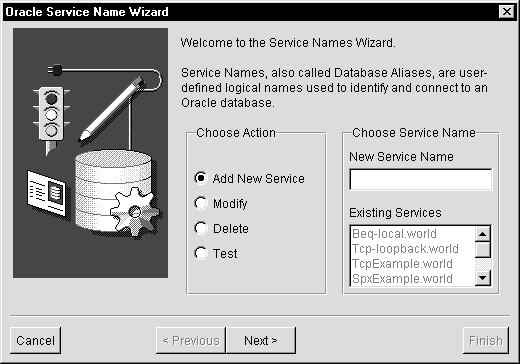
The next window appears:
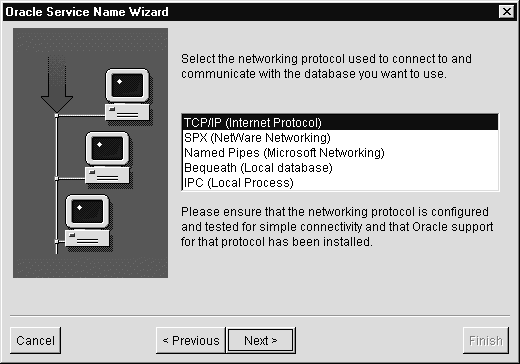
The window appropriate for your protocol adapter appears; in the example here, TCP/IP is assumed:
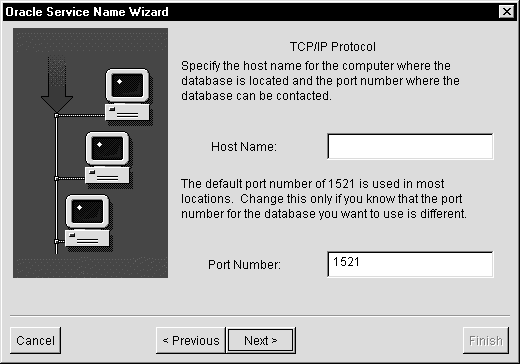
The next window appears:

The following window appears:
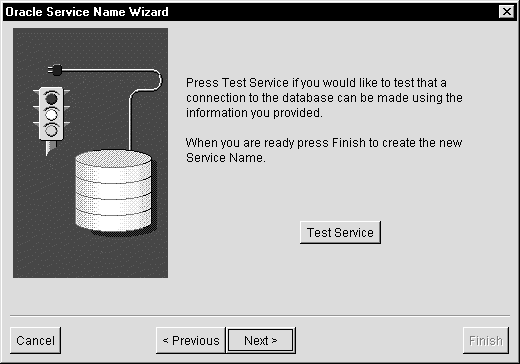
Oracle Net8 Easy Config adds the new service names to the TNSNAMES.ORA in ORACLE_HOME\NET80\ADMIN.
After the server is configured, it is best to simply copy over the TNSNAMES.ORA configuration file located at ORACLE_HOME\NET80\ADMIN on the server to the same location on the clients. This will ensure the files are consistent. Otherwise, you must use the Oracle Net8 Easy Config tool on every client, introducing possible errors.
Oracle Names simplifies the setup and administration of global, client/server computing networks. Oracle Names makes network address and database link information available to all nodes throughout the network. Each database server's network address is identified with a simple service name. Client applications then can request a database connection with that name rather than a lengthy address.
Oracle Names is made up of Names Servers that store a service's name and network address. Services include databases, database link definitions, and object aliases. Client applications request a connection using a simple name, rather than the lengthy address, and the name is resolved to the address by a Names Server. Oracle Names shields users and applications from changes made to the network infrastructure. It provides for centralized administration of network service names.
The diagram below shows that:
The automatic discovery features of Oracle Names version 8 enable network connectivity with virtually no configuration files.
Oracle Names version 8 includes three features to improve network performance and ease of administration:
There are significant differences between this version of Oracle Names and earlier versions:
On the server, the network listener must be configured to identify a database for an Oracle Names Server.
To configure the network listener:
To stop the network listener:
The Services confirmation dialog box appears, prompting you if it is OK to stop the service.
The network listener is stopped. The status column is blank.
The global database name specifies the name by which the network listener registers the database instance with an Oracle Names Server and the name by which the Oracle Names Server identifies a database. When clients request the connect information for a database from an Oracle Names Server, this is the alias they use. The domain must also be added to the end of this name. The domain is defined in the SQLNET.ORA file by the NAMES.DEFAULT_DOMAIN parameter. The default is set to WORLD.
Registering services with the Oracle Names Server instructs the network listener to find and register with a well-known Oracle Names Server. When the network listener starts, it looks for hosts with the well-known host names, tries to gather connection information from the Oracle Names Server, and registers its SID(s) with it.
To define a well-known Oracle Names Server:
For all clients and servers, ensure your network administrator has named the Oracle Names Servers as a well-known names server, allowing clients to access the Oracle Names Servers using the well-known name.
For example, for TCP/IP, Oracle Names Servers may be made well-known by adding aliases oranamesrvr(0-4) to the Domain Name Service (DNS) or in the
/ETC/HOSTS file.
The /ETC/HOSTS file may include the following entries:
144.25.219.146 host0 oranamesrvr0 144.25.219.147 host1 oranamesrvr1 144.25.219.148 host1 oranamesrvr2
This implies you can have as few as one well-known Oracle Names Server (whose alias would be oranamesrvr0) and as many as five (with aliases oranamesrvr0 to oranamesrvr4)
The numbers 0 to 4 indicate the order in which the client tries to contact the Oracle Names Servers, if more than one exists in the network.
| The well-known host names for TCP connections | The well-known computer Names for Named Pipes connections1 | The well-known service name for an SPX connection |
|---|---|---|
|
oranamesrvr0 |
ORANAMESRVR0 |
oranamesrvr |
|
1
Well-known Names Server names for Names Pipes must be in all uppercase. |
You may use the Oracle Names Control Utility (NAMESCTL80), or the Oracle Net8 Assistant to create a well-known Oracle Names Server.
Prior to creating a well-known Oracle Names Server, you must decide whether:
See Chapter 6, "Oracle Names," of the Oracle Net8 Administrator's Guide to help with these decisions.
Oracle recommends you have at two least Oracle Names Servers, one to act as the Oracle Names Server and one to act as a backup Oracle Names Server.
To create a well-known Oracle Names Server:
| Use the Net8 Assistant... | Use the Net8 Assistant... |
|---|---|
|
|
To configure the client and server machines:
The Oracle Net8 Assistant starts.
This file contains the names of the Oracle Names Server(s). Client machines read this file to find the addresses of Oracle Names Servers.
The Oracle Connection Manager provides three capabilities for Oracle8:
Allows you to multiplex multiple logical client sessions through a single transport connection to an Oracle server destination. This permits large numbers of users to access a single database which is running in multi-threaded server (MTS) mode, and thus increases the server's scalability. This feature is available only in a TCP/IP network.
Concentration reduces the demand on resources needed to maintain multiple connections between two processes by enabling the server to use fewer connection end points for incoming requests. This enables you to increase the total number of sessions that a server can handle. By using multiple Connection Managers, it is possible for thousands of concurrent users to connect to a server.
Provides a proxy for denying or allowing access to a database server. This feature, implemented only over the TCP/IP protocol, provides network filtering similar to that offered with a firewall.
Replaces the Multi-Protocol Interchange. Allows client and database servers operating on different protocol stacks to communicate with each other.
The clients require a TNSNAMES.ORA file or Oracle Names Server, the Oracle Connection Manager requires a CMAN.ORA, and the server requires multiplexing parameters set in the INITSID.ORA if
To configure the client:
Set the Oracle Connection Manager address through a TNSNAMES.ORA file or Oracle Names Server.
If using Oracle Names Server, the Oracle Connection Manager automatically updates the addresses in the Names Server, inserting the address for the CMAN into the existing address.
If you are using the local naming method, modify the TNSNAMES.ORA file located in ORACLE_HOME\NET80\ADMIN.
To modify the TNSNAMES.ORA file:
The Oracle Net8 Assistant starts.
The list of current service name appears:
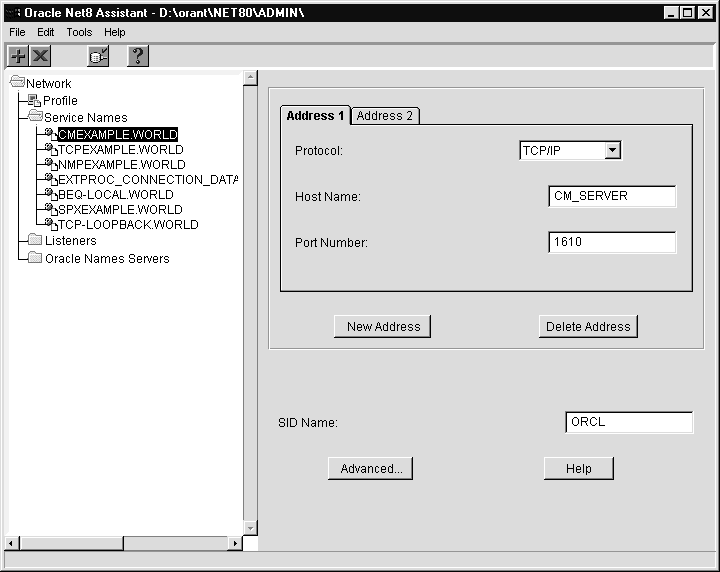
The Advanced Options dialog box appears:
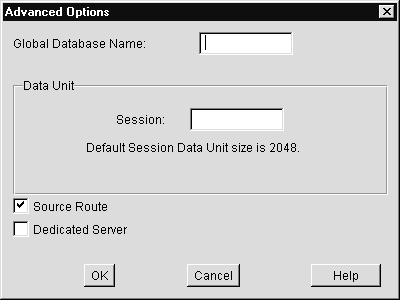
This option creates a source route of addresses through all Oracle Connection Managers to the destination address.
Below is a comparison of a regular TNSNAMES.ORA file and a TNSNAMES.ORA file with an entry to use the Oracle Connection Manager (Connection Manager entries are shown in boldface text):
Below is a TNSNAMES.ORA entry set up to use the Oracle Connection Manager with multiple protocols:
INVENTORYDB.WORLD= (DESCRIPTION= (ADDRESS_LIST= (ADDRESS= (PROTOCOL=SPX) (SERVICE=CMAN) (ADDRESS= (PROTOCOL=TCP) (HOST=INVENTORY) (PORT=1521) ) ) (CONNECT_DATA= (SID=ORCL) ) (SOURCE_ROUTE=YES) )
In this example, the client will use SPX to connect to the CMAN, then the CMAN will use TCP/IP to connect to the server. This is the same functionality that was provided with the Oracle Multi-Protocol Interchange (MPI) of Oracle7.
Configuration of the Oracle Connection Manager may require the modification of the CMAN.ORA file located in ORACLE_HOME\NET80\ADMIN if you are using protocol adapters other than TCP/IP or require additional features.
If you used protocols other than TCP/IP between the client and Oracle Connection Manager, you must modify the line beginning CMAN = (ADDRESS_LIST= to listen to the protocols adapter address the same way you would modify LISTENER.ORA file.
Section 7.3.2, "Enabling Connection Concentration Features," of the Oracle Net8 Administrator's Guide explains how to enable multiplexing.
Section 7.3.3, "Enabling Connection Concentration Features," of the Oracle Net8 Administrator's Guide explains how to enable network access rules.
If you require other optional parameters, you must remove the `#' preceding those parameters from the CMAN.ORA file.
|
Additional Information:
See "Understanding the CMAN.ORA File" in Appendix C, "Configuration Files" for a complete description of the CMAN.ORA file and it's parameters. |
To use the multiplexing, configure the server for Multi-Threaded Server (MTS) by setting MTS parameters in the INITSID.ORA for each instance. See Appendix B, "Initialization Parameter Files", in your Getting Started guide.
Once you have configured the network, test the configuration by performing a loopback test on the server.
Test the network configuration by performing a loopback test on the server. A loopback test uses Net8 to go from the server back to itself, bypassing the Interprocess Communication (IPC). Performing a successful loopback verifies that Net8 is functioning on the server side.
To start an Oracle Names Server:
If the STATUS command indicates the Oracle Names Server is running, go to Step 3. If the Oracle Names Server is not running, go to Step 2.
The Services window appears. Look for the OracleHOME_NAMENamesService80 service. A blank in the Status column indicates that the service is not running. If the service is already running, close the window and go to the section "Step 2: Start the Network Listener".
The service starts.
Use the control utility NAMESCTL80...
Use the Windows NT Control Panel...
C:\> NAMESCTL80
NAMESCTL> STATUS
NAMESCTL> START
NAMESCTL> EXIT
For Net8 to accept connections on the server, a network listener must be started. If you have started an Oracle Names Server, the network listener upon startup automatically registers the databases specified in the SID_LIST_LISTENER_NAME section of the LISTENER.ORA file with the well-know Oracle Names Servers.
To start the network listener:
where LISTENER_NAME is the name of the network listener defined in the LISTENER.ORA file with the alias LISTENER. It is not necessary to identify the network listener if you are using the default network listener, named LISTENER.
If the
SET PASSWORD is only required if the password is set in the LISTENER.ORA file. The password defaults to ORACLE.
OracleHOME_NAMETNSListener80LSNR is created if this command is run for the first time against a non-default network listener name.
The Services window appears. Look for OracleHOME_NAMETNSListener80 (the service name if you are using the default network listener name LISTENER) or OracleHOME_NAMETNSListener80LSNR (where LSNR is the non-default network listener name). OracleHOME_NAMETNSListener80LSNR is only created if the following command has been run:
A blank in the Status column indicates that the service is not running. If the service is already running, close the window and go to the section "Step 3: Start Oracle Connection Manager(s)".
The service starts.
Use the control utility LSNRCTL80...
Use the Windows NT Control Panel...
C:\> LSNRCTL80
LSNRCTL> STATUS LISTENER_NAME
STATUS command indicates the network listener is running, go to Step 2. If the network listener is not running, go to Step 3.
LSNRCTL> SET PASSWORD PASSWORD
LSNRCTL> START LISTENER_NAME
LSNRCTL> START LISTENER_NAME
LSNRCTL> EXIT
LSNRCTL80 START LISTENER_NAME
To start an Oracle Connection Manager:
Perform a loopback test on the server using Oracle Net8 Easy Config.
To perform the loopback test:
Oracle Service Name Wizard window appears.
The Connection Test window appears:
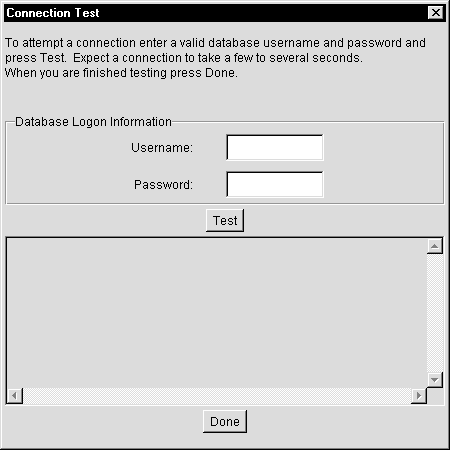
The status of the test appears in the field below the Test button. A successful test display the following message:
The connection test was successful.
The final window appears.
Oracle Net8 Easy Config modifies the service name in the TNSNAMES.ORA located in ORACLE_HOME\NET80\ADMIN.
After performing a loopback test, use the mechanisms below to test client connections:
If you are using TCP/IP, follow the instructions below to specify the destination address for TCP/IP and use PING to see if the server is running.
Most TCP/IP transports attempt to use the DNS. DNS is a mechanism used to translate the host name specified in the TNSNAMES.ORA file into the host internet address (IP). If a DNS is present on your network and the TCP/IP vendor supports DNS, the host name is successfully translated to the host address. The host IP address can be determined by using the Control Panel's Network utility to access DNS information.
Depending on your vendor, workstation configuration, and network configuration, your TCP/IP software can also use a HOSTS file to map host names to Internet addresses if DNS is not detected or supported.
If DNS and the HOSTS file are unable to resolve the host name during a remote database connection, the following error message appears:
ORA-12545: TNS: name lookup failure
If your network administrator cannot resolve the problem, the solution to this error message is go around DNS and the HOSTS file by modifying the (HOST = SERVER_NAME) section of the TNSNAMES.ORA so SERVER_NAME is changed to the IP address of the server.
The following sections explain how to determine the server's IP address and verify that DNS and the HOSTS file are working correctly.
If you are not using TCP/IP, go to "Verify Oracle Database Connections Using TNSPING" in this chapter.
The instructions below explain how to determine the IP address from Windows NT 4.0. The instructions are different on Windows NT 3.51. Please see your operating system documentation for specific DNS information.
To determine the server's TCP/IP internet address:
The Protocols view appears:
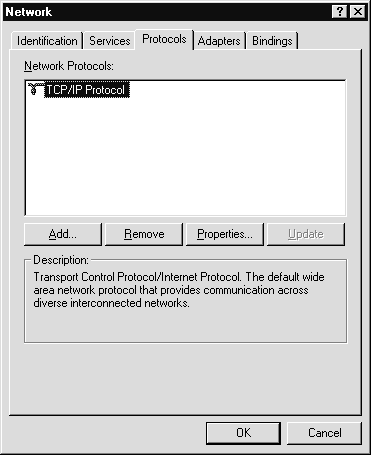
The Microsoft TCP/IP Properties dialog box appears with the IP Address view:

If you are using TCP/IP, PING allows you to determine if DNS or the HOSTS file are correctly set up and your network operating system is functioning correctly.
To use PING:
From the client, enter:
C:\> PING SERVER_NAME
where SERVER_NAME is the host name, alias, or Internet address of the server to which you are trying to connect. If your network is functioning correctly, the following message appears:
Reply from SERVER_NAME: bytes=nn time=nnms
If there is a problem, this message appears:
Request timed out
Or:
Reply from SERVER_NAME: Destination host unreachable
The following is a partial list of reasons why a host is inaccessible:
If PING returns an error message, ask your network administrator to help you resolve the problem. If the problem is not resolved, and you attempt to make a Net8 connection, you may receive one of the following error messages:
Use the TNSPING80 utility to determine whether or not you can reach the network listener service. TNSPING80, however, never actually connects with the network listener. A socket is never created and opened. TNSPING80 only checks to ascertain that a network listener is present on the server side.
When you connect to a network listener using TNSPING80, an estimate of the round trip time in milliseconds appears. If TNSPING80 fails, a network error message appears without the resource use of a database connection.
To use TNSPING80:
From the client, enter:
TNSPING80 SERVICE_NAME COUNT
where SERVICE_NAME is the service name (defined in the TNSNAMES.ORA) and count is the number of times the program attempts to reach the server. count is optional.
The output looks like:
TNS Ping Utility for 32-bit Windows: Version 8.0.4.0.0 - Production on 27 OCT-97 20:20:33 Copyright, 1997(c) Oracle Corporation 1997. All rights reserved. Attempting to contact (ADDRESS=(COMMUNITY=tcp.world)(PROTOCOL=TCP)(Host=host_name)(Port=1521)) OK (60 msec)
Use the Oracle Net8 Easy Config application to determine whether or not you can reach the network listener service.
To verify connectivity for a client machine:
Oracle Service Name Wizard window appears.
The Connection Test window appears:
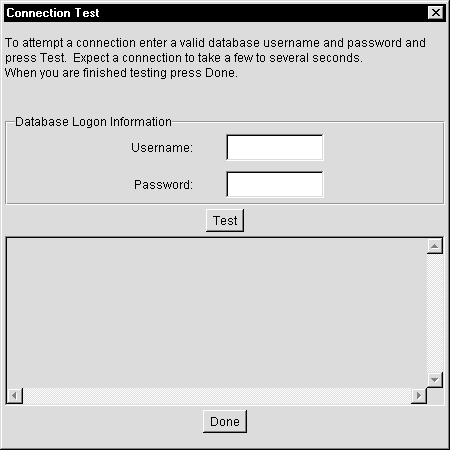
The status of the test appears in the field below the Test button. A successful test display the following message:
The connection test was successful.
The final window appears.
Oracle Net8 Easy Config modifies the service name in the TNSNAMES.ORA located in ORACLE_HOME\NET80\ADMIN.